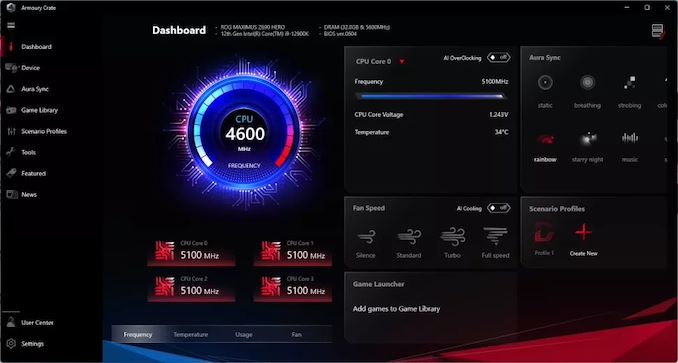The ASUS ROG Maximus Z690 Hero Motherboard Review: A Solid Option For Alder Lake
by Gavin Bonshor on June 15, 2022 8:00 AM EST- Posted in
- Motherboards
- Intel
- Asus
- ROG
- DDR5
- PCIe 5.0
- Alder Lake
- 12th Gen Core
- Z690
- LGA1700
BIOS
For the Z690 chipset, ASUS has kept the GUI the same as previous iterations of its ROG and Intel-based motherboards. It uses a red and black background at the top, with a dark grey main panel with white text and a red highlighting when mousing or selecting over a specific option. ASUS includes two modes in the BIOS, the EZ Mode for a basic overview of information and installed hardware, and the Advanced section, which opens up all of the board's customizable options, including overclocking and chipset related options.
The most prominent section within the Advanced area of the firmware is the Extreme Tweaker area. In this section, users can overclock the Performance (P) cores, the Efficiency (E) cores, the memory, and the integrated graphics. There are extensive options for all three main areas for users to overclock, including an extensive array of customizable memory latencies for fine-tuning. In addition to this, the ROG Maximus series also has a wider variety of voltage control options for CPU, memory, System Agent, and SoC than ASUS's cheaper boards.
ASUS even includes a hardware monitor, a fan tuning section within the BIOS, and easy quick links to various sections of firmware along the top. This includes ASUS AURA for customizing the integrated RGB LED lighting, ASUS's AI OC guide, Resizeable BAR, and integrated MemTest86 software for diagnosing memory issues.
Overall, the ASUS ROG firmware is intuitive, stylish, and most importantly, easy to navigate and has lots of customizable options. As we typically see with premium motherboards such as ASUS's ROG Maximus series, there are usually more overclocking options and finer control over voltages for those enthusiasts that like to push the limits. Users looking for a plug and play or those looking to tweak will find plenty of functionality within the ROG Maximus Z690 Hero firmware.
Software
Most ASUS's software bundle revolves around two main applications, the ROG Armory Crate and the Ai Suite 3 software. Upon setting up a system for the first time, ROG Armory Crate allows users to install critical updates such as networking and chipset drivers directly from a pool of designated memory on the board to get things up and running.
Not only does the Armory Crate allow users to keep drivers and software up-to-date, but it has a range of functions, including ASUS AURA Sync, fan speed control, as well as one-click access to ASUS's AI automatic overclocking.
The AI Suite 3 software has a more in-depth variety of settings that allow users to customize power delivery profiles and apply power efficiency states and software overclocking. With the new technology on Intel's Alder Lake, when used in conjunction with Intel's Extreme Tuning Utility (XTU), users can also apply Intel's one-click overclocking function. We prefer their more aggressive profiling regarding ASUS as the firmware has a look-up table with certain variables for more performance. However, this will generate more heat and power consumption.
Overall, ASUS's software tools provide many avenues to customize things such as RGB LED lighting, make auditory adjustments via Sonic Studio and the Realtek Audio applications, and control fan speeds. It's a more well-rounded selection of software with fewer apps but more functionality.
























40 Comments
View All Comments
meacupla - Wednesday, June 15, 2022 - link
People who want thunderbolt ports.NaterGator - Wednesday, June 15, 2022 - link
"Insert audio caps details." Yes, please. ;)Kevin G - Wednesday, June 15, 2022 - link
I wish Windows would properly support AVB as that’d enable the I-225 NIC to output audio to say a PoE based speaker.erotomania - Wednesday, June 15, 2022 - link
My audio caps details could really use some insertion.James5mith - Sunday, June 19, 2022 - link
Same.DBW49 - Wednesday, June 15, 2022 - link
You might want to discuss the memory power supply capacitor issues with early versions of this board. Short version: some boards had a surface mount electrolytic capacitor installed with reverse polarity. In some cases, there would be a fire. ASUS recognized the issue and provided repair services for the boards, at the cost of about 2 weeks down time (transportation and repair). That said, I am very pleased with the board.Silver5urfer - Wednesday, June 15, 2022 - link
I would suggest every single DDR5 owner to skip 4DIMM mobos. They are slower, get 2DIMM ones like APEX or Unify X or Tachyon (I think GB is worst when it's about DRAM speed with Z590).Also I hate ASUS on how their QC is absolute trash. I had to order a lot of boards to get the board which didn't have a chip on the mobo edges. All the boards brand new in box, even box condition is super neat had some or other chips on the edges of the boards. And no it's not some basic mobo I'm talking about Maximus line - Hero, Apex class. Even then I had to settle with one which had a small scratch on the Chipset heatsink to the brushed metal finish. Because I do not want to swap this and get another chipped board, some boards had the DIMM slot plastic having a hazy finish too.
Tilmitt - Thursday, June 16, 2022 - link
Will there ever be a CPU or GPU review on this site again?PeachNCream - Thursday, June 16, 2022 - link
Non0x1ous - Thursday, June 16, 2022 - link
Its the weirdest thing ever. #1 GPU review site on earth forever, then miss 1 gpu launch then miss them all and haven't had one since. All without any explanation. It's mind boggling @ryansmith